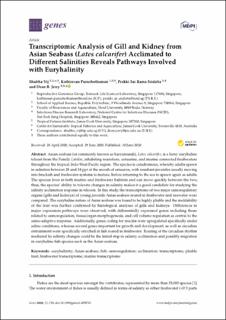| dc.contributor.author | Vij, Shubha | |
| dc.contributor.author | Purushothaman, Kathiresan | |
| dc.contributor.author | Sridatta, Prakki Sai Rama | |
| dc.contributor.author | Jerry, Dean R. | |
| dc.date.accessioned | 2021-03-04T08:48:59Z | |
| dc.date.available | 2021-03-04T08:48:59Z | |
| dc.date.created | 2021-02-18T15:23:44Z | |
| dc.date.issued | 2020 | |
| dc.identifier.citation | Vij, S., Purushothaman, K., Sridatta, P. S. R. & Jerry, D. R. (2020). Transcriptomic analysis of gill and kidney from Asian seabass (Lates calcarifer) acclimated to different salinities reveals pathways involved with euryhalinity. Genes, 11(7): 733. doi: | en_US |
| dc.identifier.issn | 2073-4425 | |
| dc.identifier.uri | https://hdl.handle.net/11250/2731564 | |
| dc.description.abstract | Asian seabass (or commonly known as barramundi), Lates calcarifer, is a bony euryhaline teleost from the Family Latidae, inhabiting nearshore, estuarine, and marine connected freshwaters throughout the tropical Indo-West Pacific region. The species is catadromous, whereby adults spawn in salinities between 28 and 34 ppt at the mouth of estuaries, with resultant juveniles usually moving into brackish and freshwater systems to mature, before returning to the sea to spawn again as adults. The species lives in both marine and freshwater habitats and can move quickly between the two; thus, the species’ ability to tolerate changes in salinity makes it a good candidate for studying the salinity acclimation response in teleosts. In this study, the transcriptome of two major osmoregulatory organs (gills and kidneys) of young juvenile Asian seabass reared in freshwater and seawater were compared. The euryhaline nature of Asian seabass was found to be highly pliable and the moldability of the trait was further confirmed by histological analyses of gills and kidneys. Differences in major expression pathways were observed, with differentially expressed genes including those related to osmoregulation, tissue/organ morphogenesis, and cell volume regulation as central to the osmo-adaptive response. Additionally, genes coding for mucins were upregulated specifically under saline conditions, whereas several genes important for growth and development, as well as circadian entrainment were specifically enriched in fish reared in freshwater. Routing of the circadian rhythm mediated by salinity changes could be the initial step in salinity acclimation and possibly migration in euryhaline fish species such as the Asian seabass. | en_US |
| dc.language.iso | eng | en_US |
| dc.publisher | MDPI | en_US |
| dc.rights | Navngivelse 4.0 Internasjonal | * |
| dc.rights.uri | http://creativecommons.org/licenses/by/4.0/deed.no | * |
| dc.title | Transcriptomic analysis of gill and kidney from Asian seabass (Lates calcarifer) acclimated to different salinities reveals pathways involved with euryhalinity | en_US |
| dc.type | Peer reviewed | en_US |
| dc.type | Journal article | en_US |
| dc.description.version | publishedVersion | en_US |
| dc.rights.holder | © 2020 The Author(s) | en_US |
| dc.subject.nsi | VDP::Matematikk og Naturvitenskap: 400::Basale biofag: 470::Genetikk og genomikk: 474 | en_US |
| dc.subject.nsi | VDP::Matematikk og Naturvitenskap: 400::Zoologiske og botaniske fag: 480::Zoofysiologi og komparativ fysiologi: 483 | en_US |
| dc.source.pagenumber | 20 | en_US |
| dc.source.volume | 11 | en_US |
| dc.source.journal | Genes | en_US |
| dc.source.issue | 7 | en_US |
| dc.identifier.doi | 10.3390/genes11070733 | |
| dc.identifier.cristin | 1891448 | |
| dc.source.articlenumber | 733 | en_US |

